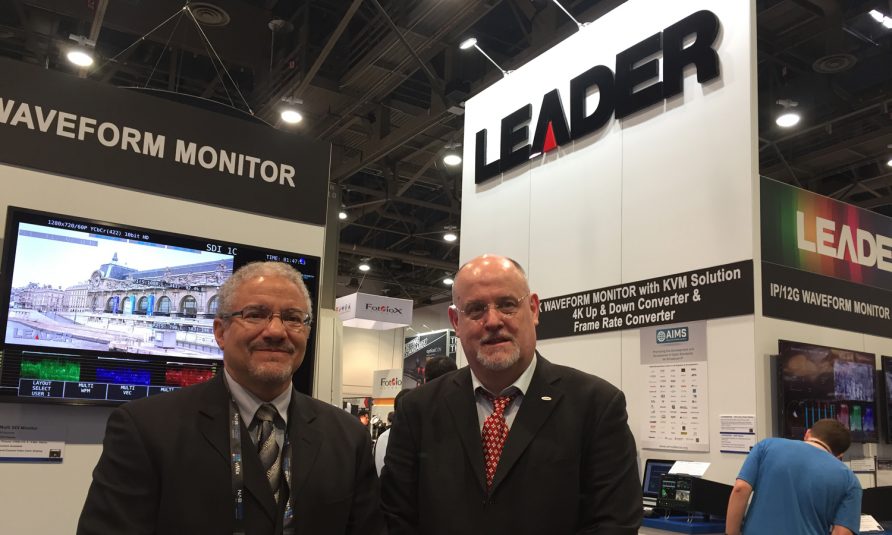NAB Reflections: Leader’s Kevin Salvidge, Peter Anderson on Tough Decisions Surrounding 4K vs. 1080p HDR and IP vs. 12G
The jury is still out on benefits of 4K; the industry awaits standards on IP
Many broadcasters are at a major crossroads in their technological histories. Key decisions hover on the horizon for many, whether it’s between going fully 4K or riding the wave of the benefits of high dynamic range (HDR) and the boost it gives to 1080p and whether it’s time to pull the trigger on IP despite the lack of a clear path to industry-wide standards.
At NAB 2017, Leader Instruments — which specializes in top-of-the-line waveform monitors, rasterizers, and video/sync generators — faced many of these questions from current and prospective clients within the industry.
SVG got the chance to sit down with Leader’s Kevin Salvidge, who is European Regional Development Manager, Europe, and Sales Director Peter Anderson, to discuss the great industry challenges and how their company helps broadcasters approach them wisely.
What is Leader Instruments’ stance on the back and forth going on now over 4K HDR or 1080p HDR. I’m sure you are happy to accommodate whatever anyone wants to do, but what are the advantages and the disadvantage of either?
Peter Anderson: I think it’s going to appeal really to two different segments, in effect. The higher project — the motion picture, the special event, and so forth — I think will focus still on 4K and take advantage of high dynamic range. That’s also in terms of streaming with companies like Netflix and Amazon. But I think the reality for the broadcast side is, the networks and TV stations see the reality as being simply HD high dynamic range. So we’ve added that to our units, and we can accommodate either depending on which way the customer goes.
Kevin Salvidge: The [market] is going to come to a point where [consumers] won’t be able to buy HD displays anymore. Broadcasters are looking at this and viewing 4K on its own and determining that it doesn’t have a wow factor. We certainly have an issue that the size of displays and viewing distance don’t correlate. You’ve got to buy very big displays, bigger than most houses can accommodate, to see the benefit.
PA: 4K on a 30-in. TV is not very impressive.
KS: We’re seeing, in Europe, a number of the broadcasters look at the HDR piece because these new UHD TVs will support HDR. They also handle HD, so they see this as being a very cost-effective way for them to make their product look better, to put a wow factor back into it. Resolution on its own probably doesn’t; the HDR piece does give it that wow factor.
What are some of the common pain points that current and potential clients are asking Leader to help them resolve?
KS: I would say this: in the European perspective, a lot of people came [to NAB 2017] hoping that [with] video over IP and SMPTE 2110, there would be light at the end of the tunnel. The noise is that it’s on schedule and it’s on track from SMPTE. AIMS is reassuring, but we don’t know what that schedule, what that track, what that timeline is.
I think the thing this industry might have to be careful of is, if there isn’t movement on this IP standard, 12-gig could start to get a bit of a critical mass, which could make those customers who need to make the investment in new facilities in the next 12-18 months sway towards 12-gig. Once they do that, they’re out of the game for the next five to seven years from an IP perspective. It’s a tough spot.
There are some people showing qualified product based on the current draft document, and the level of interoperability being shown is very controlled. The benefits of IP, however, we haven’t hit them yet. That comes when you split the audio and the video and start to be able to do the clever independent workflow and then merge them back together.
PA: A year or so ago, it seemed like 12G was actually in the lead. People wanted to get away from the idea of having four separate SDI cables, and 12G seemed to be the solution. But now I think IP is pulling ahead, and, so far, people see that there’s going to be additional benefits from going in that direction. That’s why we have people coming into our booth and asking us where we stand at this particular point. As Kevin mentioned, we have joined AIMS, so we’re keeping track of what’s happening in regards to the standard. I’m sure we’ll be able to address that, but we like to see exactly when that’s ratified and the details so that we can then move ahead. But, certainly, many customers are asking because they see that as being more viable for the future, I think 12G.

